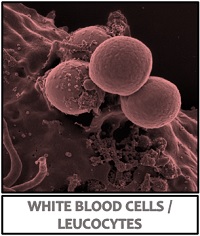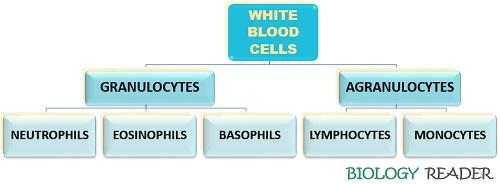The difference between RBC and WBC is mainly due to the following properties like colour, morphology and function. RBC stands for Red blood cell. WBC stands for white blood cell.
Colour: The terms (red blood cell and white blood cell) clear the colour difference. The reason behind the red colour of the RBCs is due to the iron atom present in the haemoglobin pigment. The white blood cells are colourless because they lack any coloured pigment.
Morphology: The structure of red blood and white blood cells have a characteristic shape. Red blood cells resemble a shallow bowl, as they have a flattened centre and elevated margin. White blood cells seem like amoeboid cells, as they have an irregular margin.
Function: Both red blood and white blood cells belong to the circulatory system, in which the former facilitates the gaseous exchange between the cardiovascular system and the latter provides resistance against the infection and pathogen attack.
Content: RBC Vs WBC
Comparison Chart
| Properties | RBC | WBC |
|---|---|---|
| Stands for | Red Blood Cell | White Blood Cell |
| Alternative name | Erythrocytes | Leukocytes |
| Shape | Biconcave, disc-like | Irregular, amoeboid-like |
| Diameter | 7.5 µm | 15 µm |
| Colour | Red coloured due to haemoglobin pigment | Colourless and does not contain such pigment molecules |
| Method of production | Erythropoiesis | Leucopoiesis |
| Regulatory hormone | Erythropoietin hormone | Leucopoietin hormone |
| Origination | Bone marrow | Bone marrow, lymph nodes, spleen etc. |
| Nucleus | Absent | Present |
| Motility | Non-motile | Motile |
| Life span | 100-120 days | 12-20 days |
| Constitution in blood | 36-50% | Around 1% |
| Circulatory movement | Moves between the cardiovascular system | Moves between the cardiovascular and lymphatic system |
| Cell count/µl of blood | 4.7-6.1 million/µl | 4500-11000/µl |
| When cell count increases | Leads to Polycythaemia | Leads to Leukocytosis |
| When cell count decreases | Leads to anemia | Leads to Leukopenia |
| Measurement | Can be measured by using haemocytometer via RBC pipette | Can be measured by using haemocytometer via WBC pipette |
| Number increments | Cell count of RBCs increases by the uptake of iron-rich food, doing exercise etc. | Cell count of WBCs increases by any kind of foreign attack |
| Types | It has no subtypes | These are of five kinds: neutrophil, eosinophil, basophil, lymphocytes and monocytes |
| Functional role | Helps in circulation of oxygenated blood and nutrients throughout the body | Provides protection against the pathogens and removes the infected cells via phagocytosis |
Definition of RBC
RBC is an acronym of the term “Red Blood Cell”. It refers to the component of blood or a type of blood cells, which originates from the bone marrow, attains maturity for at least seven days and finally enters the bloodstream to transport O2 and CO2 into and out of the body.
The formation of red blood cells is regulated by a hormone “Erythropoietin” produced primarily by the juxtaglomerular cells of the kidney through a process “Erythropoiesis”.

“Reticulocytes” are immature RBCs. Oppositely, “Erythrocytes” are the mature RBCs. The structure of mature RBCs lacks a nucleus and other cell organelles like ribosomes, mitochondria etc., and they can modify their shape.
The red blood cells move freely in the bloodstream, and they can flexibly pass through the small blood vessels and capillaries. RBCs possess red colour due to the presence of protein pigment “Haemoglobin”.
Haemoglobin is an oxygen-carrying pigment, which contains four iron atoms that bind to the four oxygen molecules. Therefore, haemoglobin is the major component of red blood cell that imparts a red colour and facilitates the transportation of oxygenated blood from the lungs to the other body parts and carbon dioxide from the other body parts back into the lungs.
Mutation in the haemoglobin gene can cause abnormal disease like sickle cell anaemia, where the oval shape of RBCs changes to sickle-like. “Haematocrit” is a standard unit that measures the volume of RBCs.
The method determining the RBC ratio in the blood is known as the “Haematocrit test”. The “Homeostasis” is an equilibrium state in which the degradation and production occur simultaneously, or it maintains the RBCs concentration.
Definition of WBC
WBC is an abbreviation of the term “White Blood Cell”. It refers to the component of blood or a type of blood cells, which also originates from the bone marrow and attains maturity in the organs like lymph nodes, spleen and thymus gland.
The production of white blood cells is regulated by a hormone “Leucopoietin” that stimulates myeloid cells’ production through a process “Leucopoiesis”.

Based on cell lineage, myeloid and lymphoid cells are the two common types of leucocytes. A myeloid stem cell produces monocytes and myelocytes (neutrophils, eosinophils and basophils), while a lymphoid stem cell produces lymphocytes.
Similarly, based on specific cytoplasmic granules, granulocytes and agranulocytes are the two common types of leucocytes. The granulocytes involve neutrophils, eosinophils and basophils and possess distinct granules in the cell cytoplasm. In contrast, non-granulocytes include monocytes and lymphocytes, which consist of non-distinct or non-functional granules.

- Neutrophils are phagocytic cells. They become activated against acute infection due to bacterial and fungal attack.
- Eosinophil stimulates in counter to any parasitic infections.
- Basophils target the allergic sites, especially in the case of type-1 hypersensitivity.
- Monocytes present the antigenic fragments to the T-cell and target the chronic infection site.
- Lymphocytes are of two kinds. B-lymphocytes produce antibodies to neutralize the antigenicity or block the pathogen invasion, and T-lymphocytes activate in counter to the viral and chronic infection.
Key Differences Between RBC and WBC
- Erythrocytes, red cells or red blood corpuscles are the alternative names for RBC, and leukocytes, white cells, or white blood corpuscles are the alternative names for WBC.
- The diameter or size of the RBCs is much smaller (7.5 µm) comparative to the width of WBCs (15 µm).
- A structure of RBC lacks a nucleus, i.e. “Anucleated”, while WBC contains a distinct nucleus, i.e. “Nucleated”.
- The RBCs have a life span of about 100-120 days, whereas WBCs have 12-20 days of life span.
- Red blood cells constitute about 36-50% of the total blood, while white blood cells contribute nearly 1% of the total blood.
- The circulatory movement of RBC is between the cardiovascular system, whereas WBC moves between the cardiovascular and lymphatic system.
- A normal range of RBC per microliter of blood sample is between 4.7-6.1 million. Any alternations in the normal RBC concentration turns into a medical condition known as Polycythaemia (RBC count increases) and Anaemia (RBC count decreases). A normal range of WBC per microliter of blood sample is between 4500-11,000. The increase and decrease in the WBC count turn into a medical condition known as Leukocytosis and Leukopenia, respectively.
Similarities
- Both RBC and WBC are the kinds of blood cells, which are the universal constituents of blood.
- Haematocrit test is a complete blood count test that can measure the cell concentration of RBC (represented as haematocrit) and the concentration of WBC (represented by the Buffy layer).
- Both RBC and WBC are produced by the haematopoietic stem cells, and the process is commonly called haematopoiesis.
- The cell number of both red blood and white blood cells can be determined using a Neubauer counting chamber or haemocytometer under the microscope.
Conclusion
Therefore, we can conclude that RBCs and WBCs are a part of the circulatory system, which perform distinct functions to boost the body’s immunity and metabolism.
Comparison about red blood cells and white blood cells, is too good information for me and other people’s. You provided great information about this.